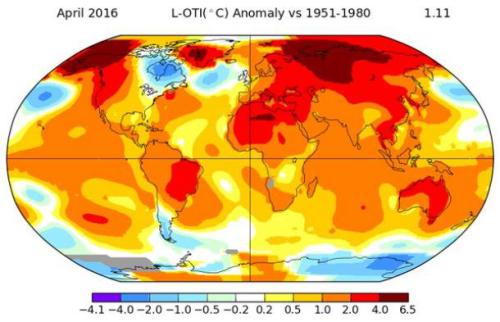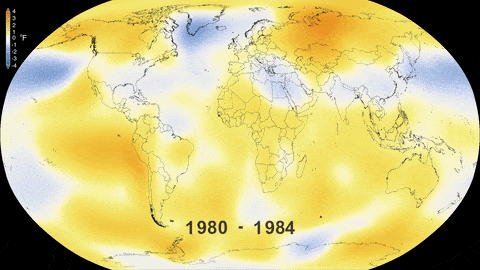File:Earth gets hotter May2016.jpg
Earth_gets_hotter_May2016.jpg (500 × 322 pixels, file size: 28 KB, MIME type: image/jpeg)
The data, atmospheric and earth science...
Via NASA's Goddard Institute for Space Studies
NEWS | May 15, 2017 | April 2017 was second-warmest April on record
Via the World Meteorological Organization:
http://public.wmo.int/en/media/news/april-continues-record-temperature-streak
- Global temperature records were broken yet again in April 2016 for the 12th consecutive month, the longest such streak in the 137-year record of the U.S. National Oceanic and Atmospheric Administration (NOAA). Overall, 13 out of the 15 highest monthly temperature departures in the record have all occurred since February 2015.
- NOAA said the combined average temperature over global land and ocean surfaces for April 2016 was 1.10°C (1.98°F) above the 20th century average of 13.7°C (56.7°F) – the highest temperature departure for April since global records began in 1880. This value surpassed the previous record set in 2010 by 0.28°C (0.50°F).
- The global analysis from NOAA confirmed the findings of separate datasets from NASA and the Japan Meteorological Administration.
- Globally-averaged temps thru 2015
- Via NASA Goddard
“Another month, another record,” said WMO Secretary-General Petteri Taalas.
“The extraordinary heat that was recorded in 2015 pales by comparison to 2016.”
“The rapid implementation of the Paris Climate Change agreement is taking on the utmost urgency, if the ambitious 1.5-2.0 C targets would be reached,” said Mr Taalas.
- “For the first time ever, carbon dioxide concentrations in the southern hemisphere have joined those in the northern hemisphere and passed the 400 parts per million level. They are likely to stay there. This is more than just a symbolic threshold. At the current rate of increase in CO₂ levels, we are on track to reach the 2°C temperature limit within the next two generations,” said Mr. Taalas.
- Measurements at Cape Grim on Tasmania’s northwest coast reached the 400 ppm milestone on 10 May and at Casey Station in Antarctica on 14 May, according to CSIRO and the Bureau of Meteorology of Australia. The stations form part of WMO’s Global Atmosphere Watch network, which spans 100 countries, including stations high in the Alps, Andes and Himalayas, as well as the Arctic and Antarctic.
CO₂ concentrations over the southern hemisphere are trailing those in the planet’s northern half, where 400 ppm level was breached in 2014-15.
Human activity has increased the direct warming effect of CO₂ in the atmosphere by 50 percent above pre-industrial levels during the past 25 years, according to NOAA’s 10th Annual Greenhouse Gas Index...
The April globally averaged sea surface temperature was 0.80°C (1.44°F) above the 20th century monthly average, the highest on record.
According to data from NOAA analyzed by the Rutgers Global Snow Lab, the Northern Hemisphere snow cover extent during April was 890,000 square miles below the 1981–2010 average. This was the smallest April Northern Hemisphere snow cover extent in the 50-year period of record...
○
File history
Click on a date/time to view the file as it appeared at that time.
| Date/Time | Thumbnail | Dimensions | User | Comment | |
|---|---|---|---|---|---|
| current | 23:06, 20 May 2016 |  | 500 × 322 (28 KB) | Siterunner (talk | contribs) |
You cannot overwrite this file.
File usage
The following 3 pages use this file:
- Atmospheric Science
- Climate Change
- Global Warming
- Green Graphics
- Planet Citizen
- Planet Citizens, Planet Scientists
- Anthropocene
- Climate Policy
- Desertification
- Earth Observations
- Earth360
- Earth Science
- Earth Science from Space
- Environmental Protection
- Environmental Security
- Environmental Security, National Security
- Extinction
- Green Politics
- INDC
- NASA
- Natural Resources
- New Definitions of National Security
- Strategic Demands
- Ocean Science
- Renewable Energy
- Resilience
- Sea-level Rise
- Sea-Level Rise & Mitigation
- Solar Energy
- Sustainability Policies
- US Environmental Protection Agency
- Whole Earth

